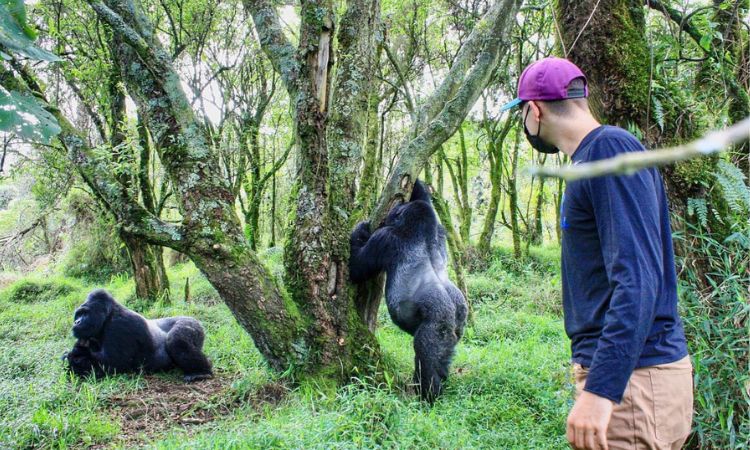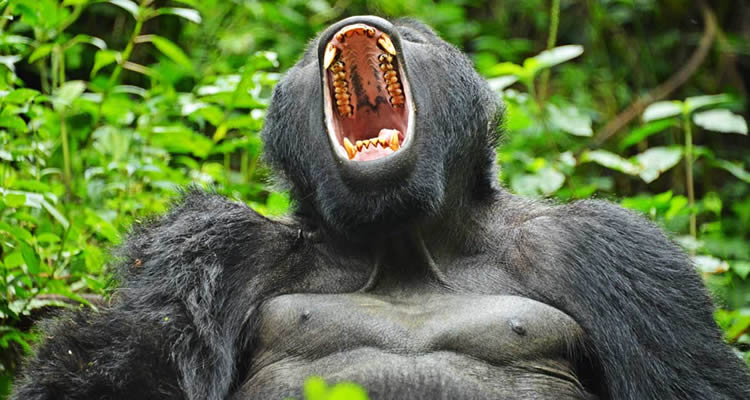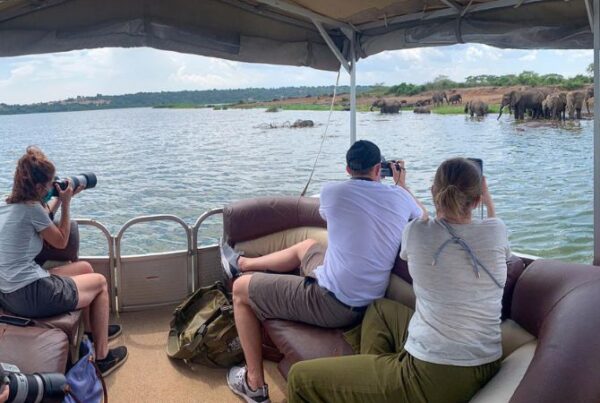Silverback Gorilla
The Majestic King of the Forest
Amid the mist-laden mountains of central and eastern Africa, where towering forests and volcanic landscapes shape the horizon, dwells one of the most powerful yet gentle beings of the natural world—the silverback gorilla. Known as the leader and protector of gorilla families, the silverback commands respect not only for his immense strength but also for his wisdom, tenderness, and extraordinary sense of responsibility. To witness a silverback in his natural habitat is to encounter a living emblem of nature’s grandeur and complexity, a creature whose very presence embodies authority yet radiates profound calm.
The fascination with silverback gorillas goes far beyond their physical strength. They are symbols of family, unity, and survival, guiding their groups—called troops or families—through dense forests while maintaining peace and order within their communities. Their silvered backs, a striking feature that emerges with age and maturity, are more than mere physical traits; they represent the culmination of a gorilla’s journey into leadership.
To understand the silverback gorilla is to delve into a narrative where power meets compassion, and where one of humanity’s closest relatives reveals what it means to be a true guardian of life.
The Identity of the Silverback Gorilla
The silverback is not a separate species but the adult male gorilla who has reached a stage of maturity marked by the growth of silver-gray hair along his back and hips. This transformation usually occurs between the ages of 12 and 15 years, signaling both physical maturity and social authority. Standing up to 1.8 meters tall and weighing over 180 kilograms, a silverback is a formidable figure, his sheer size enough to intimidate potential threats.
Yet behind this imposing frame lies a creature of remarkable gentleness. Silverbacks are not defined solely by aggression or dominance; they are also providers, decision-makers, and nurturers. Their role is multifaceted, blending physical protection with emotional stability. Every action taken by a silverback—from where the family forages to how disputes are resolved—shapes the survival and well-being of the troop.
Taxonomy and Subspecies: The Silverback’s Place in the Animal Kingdom
Silverbacks belong to the species Gorilla, which is divided into two main species: the eastern gorilla and the western gorilla. Each species is further divided into subspecies. The eastern gorilla includes the mountain gorilla (Gorilla beringei beringei) and the eastern lowland gorilla (Gorilla beringei graueri), while the western gorilla includes the western lowland gorilla (Gorilla gorilla gorilla) and the Cross River gorilla (Gorilla gorilla diehli).
Among these, the mountain gorilla is perhaps the most iconic, especially within the misty forests of Uganda, Rwanda, and the Democratic Republic of Congo. In each of these subspecies, the silverback emerges as the unquestioned leader. Though subtle differences exist in size, habitat, and behavior, the role of the silverback as protector and guide is universal.
Physical Characteristics: The Power and Symbolism of the Silverback
The silverback gorilla is distinguished by a unique blend of strength and elegance. Muscular arms, which are longer than their legs, grant them immense power for climbing, foraging, and defending their families. Their hands and feet resemble those of humans, complete with fingernails and opposable thumbs, a constant reminder of the evolutionary kinship between gorillas and humans.
The most striking feature, however, is the silver saddle of hair that runs across their backs. This feature emerges with maturity and is both a sign of dominance and a marker of experience. To the gorilla family, the silverback is the leader, and this distinctive marking ensures that his authority is visually recognized.
Beneath the physical traits lies a physiology adapted for strength and endurance. A silverback’s chest is broad, his canines sharp and capable of delivering powerful bites, and his lungs strong enough to sustain him in high-altitude environments where oxygen is thinner. Despite this arsenal of physical attributes, silverbacks rarely display aggression unnecessarily; instead, they prefer calm authority and resort to displays of strength only when absolutely required.
The Role of the Silverback: Protector, Leader, and Father
The silverback’s role in gorilla society is far more complex than that of a dominant male. He is the central figure around whom the entire group revolves. His responsibilities are extensive, encompassing protection from predators, mediation of conflicts, and decision-making regarding movement and feeding sites.
As a protector, the silverback stands between his family and danger. Leopards, although rare, pose threats, as do human intrusions into gorilla habitats. In such moments, the silverback’s formidable size and courage are revealed through chest-beating, vocalizations, and, if necessary, physical confrontation. His presence alone often deters threats, for few creatures are willing to challenge such authority.
Beyond protection, the silverback is also a nurturer. He is often observed cradling infants, allowing young ones to play on his broad back, or comforting distressed members of the group. This blend of tenderness and strength underscores the essence of his leadership, where authority is balanced with compassion.
Decision-making rests heavily on the silverback’s shoulders. He determines when the family wakes, where they forage, when they rest, and where they nest at night. Every choice reflects his deep knowledge of the forest, acquired through years of experience. His leadership is not enforced through constant displays of dominance but through trust and respect earned from the group.
Social Structure: The Gorilla Family
Gorillas are deeply social animals, and their lives are organized within family groups that may include up to thirty members, though smaller groups are more common. At the heart of these groups stands the silverback, supported by adult females, juveniles, and infants. In some cases, younger blackback males remain in the group under the mentorship of the dominant silverback until they reach maturity and venture out to form their own families.
The cohesion of the family is a testament to the silverback’s role. He maintains peace by settling disputes, often using displays of dominance to prevent fights from escalating. Female gorillas rely on his authority for stability, while young gorillas depend on his protection and guidance as they learn the ways of the forest.
This structure is not rigid but dynamic. When a silverback grows old or is challenged by a younger male, leadership may shift. However, transitions are often peaceful, for the underlying priority remains the survival and well-being of the group rather than personal rivalry.
Behavior and Communication: The Language of Authority
The silverback gorilla communicates through a rich system of vocalizations, gestures, and expressions. Over twenty different sounds have been recorded, ranging from low grunts that indicate reassurance to loud roars that signal alarm. Chest-beating, one of the most iconic displays, is not merely a show of aggression but also a means of communication, announcing strength, warning rivals, or rallying the family.
Facial expressions are equally important. A silverback’s gaze, posture, and subtle movements convey dominance, calmness, or alertness. Through these non-verbal cues, he maintains harmony within the group, ensuring that order is preserved without constant conflict.
What is most remarkable is the silverback’s restraint. Despite his immense power, he often chooses patience over force, teaching by example and guiding his family through subtle leadership rather than fear.
Diet and Daily Life: The Provider of the Family
The silverback’s role as provider extends into the dietary habits of the group. Gorillas are primarily herbivorous, feeding on leaves, shoots, stems, fruits, and occasionally small invertebrates. Each day, the family moves across the forest in search of food, guided by the silverback’s knowledge of seasonal abundance.
Their foraging patterns reflect a balance between sustenance and conservation. Gorillas rarely overexploit a particular area, instead moving systematically to allow vegetation to regenerate. This behavior highlights the silverback’s role not only as a provider but also as a steward of the forest, ensuring that his family’s needs are met without destroying the very environment that sustains them.
Daily routines are structured around feeding, resting, and social interactions. The silverback maintains vigilance throughout, his presence ensuring that peace prevails and that young gorillas can play freely without fear.
Reproduction and Family Continuity
Silverbacks also play a crucial role in reproduction and the continuity of their family lines. As the dominant male, the silverback typically has exclusive breeding rights within the group. His genetic contribution ensures stability, and his protective nature guarantees the safety of infants.
Female gorillas, drawn to his authority and strength, remain loyal, and their offspring benefit from the security of his leadership. Infants, born after a gestation period of about eight and a half months, are carried by their mothers but often find comfort in the presence of the silverback. It is not uncommon to witness young ones climbing onto his back or resting against him, confident in his protective embrace.
Through reproduction, the silverback not only ensures the continuation of his lineage but also strengthens the stability of the troop, as each new generation carries forward the values of unity, protection, and resilience.
Threats and Conservation: The Silverback’s Fight for Survival
Despite their strength, silverback gorillas face numerous threats that endanger their survival. Habitat loss due to agriculture, logging, and human settlement reduces their living space. Poaching, though less common today, still poses dangers, while diseases transmitted by humans can devastate populations.
Climate change also threatens the ecosystems that gorillas depend upon, altering food availability and increasing competition for resources. In this context, the silverback’s role as protector becomes even more poignant, for he not only shields his family from natural predators but also faces the broader threat of human encroachment.
Conservation efforts have, however, brought hope. International collaboration, strict anti-poaching laws, and the promotion of eco-tourism have contributed to a slow but steady increase in gorilla populations. Trekking programs in Uganda, Rwanda, and the Democratic Republic of Congo provide financial incentives for conservation while creating global awareness of the gorilla’s plight.
The survival of silverbacks and their families symbolizes what can be achieved when humanity recognizes its responsibility toward nature. Each encounter with a silverback in the wild is a testament to the success of conservation, a reminder that fragile species can endure if given protection and respect.
Cultural and Symbolic Significance
Beyond the forests, the silverback gorilla has captured human imagination for centuries. To many cultures, he represents strength, wisdom, and guardianship. His image has been woven into folklore, art, and even modern conservation movements as a symbol of the delicate balance between power and responsibility.
The fascination with silverbacks is not only about their biological significance but also about the values they embody. They remind humanity of leadership rooted in service, of authority balanced with compassion, and of the possibility of harmony within communities.
Experiencing the Silverback: Encounters in the Wild
For travelers and nature enthusiasts, encountering a silverback in his natural habitat is a life-altering experience. Within the misty mountains of Bwindi, Mgahinga, Volcanoes National Park, or Virunga, the trek through dense forests culminates in a moment of silent awe when the silverback appears. His presence transforms the atmosphere, commanding respect yet exuding serenity.
To observe him guiding his family, to lock eyes with his intelligent gaze, or to hear the deep resonance of his chest-beat is to connect with nature at its most profound level. Such encounters are not mere wildlife sightings but spiritual experiences, reminding us of our shared origins and responsibilities toward the living world.
The Legacy of the Silverback
The story of the silverback gorilla is a story of strength, leadership, and survival. It is the story of a being whose life embodies the essence of guardianship, whose decisions ensure the safety of his family, and whose existence reflects the resilience of nature itself.
What should be expected in understanding the silverback is not merely admiration for his power but a deeper appreciation of his role as a leader, nurturer, and protector. His life demonstrates that true authority is not enforced by fear but earned through service, wisdom, and compassion.
For those who seek to experience this majesty firsthand, Africa offers the rare opportunity to walk among these giants and witness their world with reverence. Such journeys are best entrusted to experts who combine deep knowledge of the land with a passion for conservation. To ensure that this experience is unforgettable and responsibly guided, it is highly recommended to book your Africa tours and safaris with WildHorn Africa, a trusted partner in unveiling the wonders of the continent.





 WildHorn Africa – Authentic and unforgettable tours across Africa, guided by local experts who know the land, wildlife, and culture best.
WildHorn Africa – Authentic and unforgettable tours across Africa, guided by local experts who know the land, wildlife, and culture best.


